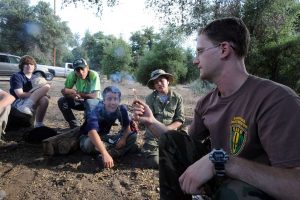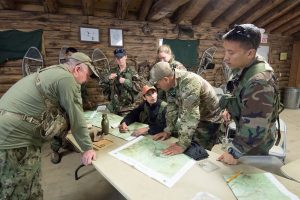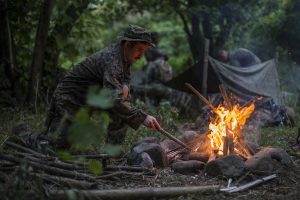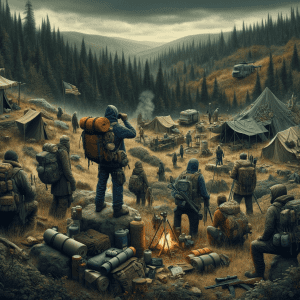In an unpredictable world, the question often arises: are we prepared for what may come?
From natural disasters to economic downturns, the threats are countless.
For some, the answer lies in becoming a ‘prepper’, a member of a growing community dedicated to self-reliance and survival in the face of adversity – the prepper community.

But what does it mean to be a part of the prepper community? How do these individuals and communities navigate the complexities of modern life while preparing for the worst? And more importantly, what can we learn from them?
One of the best fiction books out there covering this exact topic is Patriot Dawn. Although fiction, the author uses very realistic events that warrant being prepared and building a community of like-minded people.
Key Takeaways
- Prepper Community Ethos is based on self-sufficiency, collective strength and adaptability.
- Preppers strive for self-sufficiency through stockpiling supplies, training skills and networking with likeminded individuals.
- Real life examples show that preppers can create secure communities in urban or rural settings by understanding the dynamics of their group and balancing privacy & cooperation.
Understanding the Prepper Community Ethos
Three core values lay the foundation for the ethos of the prepper community: self-sufficiency, collective strength, and adaptability to modern survival challenges. It’s about more than just living off the grid or keeping a stash of canned goods. It’s a way of life that prioritizes preparedness and resilience, embodying the spirit of the famous quote, “It’s better to have it and not need it than to need it and not have it.”
This drive for self-sufficiency is not just about surviving in the wilderness or preparing for natural disasters. Being ready for any situation, from economic downturns to pandemics, is a significant aspect of it. It’s about having the skills and resources required to weather any storm and come out stronger on the other side.
Yet, preppers understand that strength does not lie only in self-reliance. They know the power of numbers and the importance of a strong community. Collective strength, in fact, is one of the pillars of the prepper ethos. Pooling resources and knowledge enhances preppers’ survival chances, benefiting not just the individuals, but the community as a whole. By working together, they can overcome challenges that would be insurmountable alone.
The Drive for Self-Sufficiency
For a prepper, self-sufficiency transcends being just a goal and becomes a lifestyle. It’s about being prepared for any eventuality, from natural disasters to societal collapse. This quest for self-sufficiency manifests in diverse ways, including procuring food and water supplies, honing survival skills, and fostering a resilient, independent mindset.
Indeed, much of the prepper ethos can be traced back to a deep-seated desire to be self-reliant. This ethos is reflected in the literature that has shaped the prepper movement. For instance, Howard Ruff’s book “Famine and Survival in America” provides advice on food storage and emphasizes the intrinsic value of precious metals.
In the wilderness, the rule of 3 is a common wilderness survival practice. It states that a human can survive:
- 3 minutes without air
- 3 hours without shelter
- 3 days without water
- 3 weeks without food
This rule underscores the urgency and importance of self-sufficiency in survival scenarios, often referred to as being in survival mode or engaging in a survival operation.
RELATED – 5 Basic Survival Skills to Learn
Strength in Numbers
While the prepper lifestyle emphasizes self-sufficiency, it also recognizes the value of collective strength. The concept of collective strength in numbers stems from the belief that a group, particularly in survival scenarios, can accomplish more than an individual, including lone wolf preppers.

Consider, for example, fortifying a bug-out location. This task would be daunting for a single individual, but an entire group of preppers working cooperatively can accomplish it with relative ease. Similarly, in a crisis, having a group to rely on can make a substantial difference in terms of survival.
The benefits of collaboration within a prepper community extend past basic survival. Having a group to rely on means pooling resources, sharing knowledge, and working together to achieve common goals. It’s about more than just surviving; it’s about thriving, even in the face of adversity.
Adapting to Modern Society’s Challenges
In today’s world, the challenges faced by preppers include:
- Natural disasters
- Societal collapse
- Fear of war
- Disease outbreaks
- Energy shortages
- Environmental disasters
- Climate change
- Economic uncertainty
These factors have led to a renewed interest in survivalism and preparedness.
In the face of these modern challenges, being prepared for disasters has become more crucial than ever. They pose genuine threats to our livelihoods, and being prepared is not just about surviving the immediate aftermath of a disaster, but also about having the ability to rebuild and thrive in the long term.
RELATED – Best SHTF Radios for Disaster Communications
Building Blocks of a Resilient Survival Community
The construction of a resilient survival community requires more than merely stockpiling supplies. It’s about understanding the roles and responsibilities of each member and leveraging local natural resources to ensure the community’s survival.
Roles within a prepper community vary, encompassing practical tasks like latrine excavation and supply stockpiling, as well as strategic ones like training and survival skill enhancement. These roles are not static but evolve based on the community’s needs and the evolving landscape of potential threats.
Aside from understanding roles and responsibilities, leveraging local resources is another key aspect of building a resilient prepper community. Whether it’s harnessing solar power, farming local land, or utilizing social media to connect with other preppers, the ability to leverage local resources is crucial to the community’s survival and success.
Essential Roles and Responsibilities
Each member in a prepper community has a specific role to fulfill. From the medic who provides vital healthcare services to the leader who ensures that communication protocols are adhered to, every member contributes to the community’s survival. Allocating roles and responsibilities isn’t just about efficiency. It’s also about ensuring that each member of the community feels valued and essential. When everyone has a role to play, everyone has a stake in the community’s survival and success.

The roles within a prepper community are as varied as the skills and backgrounds of its members. From practical skills such as hunting and gardening to strategic skills such as planning and coordinating, every member brings something unique to the table. And in a survival situation, these diverse skills can make all the difference.
Leveraging Local Natural Resources
Making use of local natural resources plays a pivotal role in the prepper lifestyle. Whether it’s using solar power for energy, harvesting rainwater for drinking, or hunting local wildlife for food, preppers understand the value of utilizing what’s readily available in their environment.
The ability to leverage local resources isn’t just about survival, it’s also about sustainability. By harnessing the power of nature, prepper communities can create self-sustaining systems that not only ensure their survival but also minimize their impact on the environment.
In addition to using natural resources for survival, prepper communities also leverage these resources for other purposes. For instance, they might use timber for building structures, medicinal plants for healthcare, or natural landscapes for training and skill development. By leveraging these resources, prepper communities can enhance their self-sufficiency and resilience.
RELATED – From Flat Tires to SHTF: Building a Vehicle Emergency Kit
Connecting with Like-Minded Preppers
Finding a survival community isn’t about looking for a group of people who share your interest in prepping. It’s about finding a group of like-minded individuals who share your values, your commitment to preparedness, and your vision for a self-reliant future.
Identifying other preppers marks just the beginning of the journey. Building connections with these individuals, learning from their experiences, and forming a supportive network is what truly makes a prepper community.
However, discovering a prepper community can sometimes pose a challenge. Many preppers value their privacy and may be hesitant to connect with others. That’s where the importance of OPSEC, or Operational Security, comes in. By maintaining OPSEC, preppers can connect with others while ensuring their personal security and privacy.
Utilizing Social Media Groups
In the digital era of today, social media platforms provide a private, secure avenue for interaction among preppers. From Facebook groups to Reddit subreddits, preppers can find a wealth of information and a community of like-minded individuals at their fingertips.

While social media offers an easy way to connect with other preppers, it’s also important to be mindful of privacy and security. This means using strong passwords, adjusting privacy settings, and being careful about what information is shared online.
Despite these challenges, social media remains a valuable tool for preppers. Whether it’s sharing survival tips, discussing common mistakes, or simply connecting with others who share their passion for preparedness, social media offers a platform where preppers can learn, grow, and support each other.
Networking in Your Area
While online connections with preppers have their worth, establishing connections with preppers in your local area is also of significant value. Through local networking, preppers can:
- Form stronger, more immediate connections
- Share resources and knowledge more easily
- Coordinate and collaborate on preparedness efforts
- Potentially even form a local prepper community

There are many ways to network with preppers in your local area. From attending local events and meetings to volunteering with local organizations, preppers have a multitude of opportunities to connect with like-minded individuals.
But networking isn’t just about finding other preppers. It’s also about learning from each other, sharing resources, and building a supportive community. By networking in your local area, you can not only find other preppers but also build a strong and resilient prepper community right in your own backyard.
Preparing for the Worst Case: When Disaster Strikes
Being prepared for any eventuality, including an shtf event, is a central tenet of prepping. This means having the skills and resources necessary to survive and thrive in the event of a disaster, such as medical emergencies.

Preparation involves more than just stockpiling supplies. It’s about understanding the potential risks and challenges that could arise in a disaster situation, and being ready to face them. Preppers train themselves to be ready for anything by:
- Learning how to purify water
- Building a shelter
- Administering first aid
- Navigating in the wilderness

However, being prepared does not equate to living in perpetual fear. Instead, it’s about taking control of your own survival and knowing that, no matter what happens, you have the skills and resources to keep yourself and your community safe.
RELATED – Best Survival Schools in the US
Stockpiling and Managing Supplies
Stockpiling supplies constitutes a crucial part of prepping. From non-perishable food items to medical supplies and ammunition, having a well-stocked supply of essential items can make all the difference in a survival situation.

However, stockpiling supplies extends beyond mere hoarding of goods. It’s about understanding what you need, how much you need, and how to store and manage these supplies effectively.
Common mistakes in stockpiling include failing to rotate supplies and allowing them to expire, and not managing inventory effectively. By avoiding these mistakes, preppers can ensure that they have the supplies they need, when they need them.

Training and Skill Development
In addition to stockpiling supplies, training and skill development form integral parts of preparedness. This includes basic survival skills such as building a fire and finding food, as well as more specialized skills such as first aid and navigation.
Training isn’t just about learning new skills. It’s also about practicing and honing these skills until they become second nature. Whether it’s learning how to purify water or how to navigate using a compass, regular training and practice are key to mastering these skills.
In addition to individual skill development, training within a prepper community can also involve group exercises and drills. These not only help to build individual skills but also foster teamwork and cooperation within the community.
RELATED – Trauma First Aid Training: Preparing Yourself for the Unexpected
The Dynamics of Small Families vs. Larger Groups
Be it a small family group or a larger community, each prepper group presents its unique dynamics. Understanding these dynamics and finding the right balance between privacy and cooperation is key to the success of any prepper community.
In a small immediate family group, maintaining privacy can be easier. There are fewer people to manage, and it can be easier to establish clear boundaries and communicate effectively. However, smaller groups may also have fewer resources and skills to draw on, making cooperation and resource sharing even more crucial.
In contrast, larger groups have more resources and skills to draw on, but may face challenges in maintaining privacy and ensuring effective communication. Despite these challenges, both small family groups and larger communities can thrive with the right balance of privacy and cooperation.
Balancing Privacy and Cooperation
Achieving a balance between privacy and cooperation in any prepper community is a nuanced task. On one hand, privacy is crucial for maintaining individual autonomy and security. On the other hand, cooperation is essential for pooling resources and skills, and for building a strong and resilient community.
Strategies for balancing privacy and cooperation include establishing clear communication channels, respecting individual boundaries, and creating a culture of trust within the community. By respecting each individual’s privacy, while also fostering a spirit of cooperation, prepper communities can ensure that everyone’s needs are met.
Furthermore, maintaining a balance between privacy and cooperation is not just about managing relationships within the community. It’s also about ensuring the community’s long-term survival and success. After all, a community that can effectively balance privacy and cooperation is a community that can face any challenge with unity and strength.
Scaling Up Operations
For larger prepper groups, the process of scaling up operations comes with its unique challenges. From coordinating activities and managing resources, to ensuring effective communication and decision-making, larger groups require a different approach to organization and management.
Effective communication is key to managing large groups. This includes not just verbal communication, but also the establishment of clear roles and responsibilities, and the implementation of effective communication tools and protocols.
When it comes to resource management, larger groups need to be particularly mindful. With more people, resources can quickly become scarce if not managed effectively. This requires careful planning, efficient storage and distribution systems, and a commitment to sustainability and resource conservation.
Real-Life Examples of Thriving Prepper Communities
The resilience and adaptability of prepper communities go beyond being mere theoretical concepts. Across the globe, there are real-life examples of prepper communities that are thriving in both urban and rural settings. From United, a prepper community focused on combating threats and preserving resources, to Vivos xPoint, a self-proclaimed largest survival community located in South Dakota’s isolated Black Hills, these communities showcase the adaptability and innovation of preppers.
These communities are not just surviving, they are flourishing. They demonstrate that with the right mindset, skills, and resources, it’s possible to create a resilient and self-sustaining community, even in the face of adversity.
Rural Retreats and Secure Locations
Rural retreats provide a perfect backdrop for prepper communities. With access to natural resources and space to develop self-sufficient lifestyles, these retreats provide preppers with the opportunity to live in accordance with their ethos. Examples of rural retreats utilized by prepper communities include Fortitude Ranch and Fortitude Camp, both located in West Virginia. These retreats offer secure locations for preppers to prepare for potential societal meltdowns. In these retreats, preppers can find the space and resources they need to practice their skills and build resilient communities.
However, successful survival retreats require more than just space and resources. They also need to be easily defensible and provisioned for essential requirements. By carefully selecting and preparing their retreats, prepper communities can ensure that they have a safe and secure base to fall back on in times of need.

Urban Adaptations and Innovations
While countryside retreats bring numerous benefits, not every prepper has the privilege of retreating there. For those living in urban environments, prepping requires a different set of skills and strategies.
Urban preppers face unique challenges, such as limited space, higher population density, and reliance on urban infrastructure. To overcome these challenges, urban preppers have developed innovative survival strategies, such as focusing on the 10 C’s of urban survival and customizing emergency plans for urban environments.
Despite the challenges, urban prepper communities have shown remarkable resilience and adaptability in modern society. By leveraging their urban environment to their advantage, these communities have shown that it’s possible to live a self-reliant lifestyle, even in the heart of the city.
Frequently Asked Questions
What is the prepping community?
Preppers are individuals or groups who proactively prepare for emergencies, such as natural disasters, and other disruptions to social order, by reducing their dependence on infrastructure and stockpiling extra resources. They understand the need to plan ahead to prevent hardship.
What are the core values of the prepper community?
The prepper community values self-sufficiency, collective strength, and adaptability in the face of modern survival challenges.
How do prepper communities leverage local natural resources?
Prepper communities leverage local natural resources to obtain energy from solar power, harvest rainwater for drinking, and hunt wildlife for food. These resources also provide materials for building structures, practicing healthcare, and developing necessary skills.
What are some challenges faced by urban prepper communities?
Urban prepper communities face a variety of challenges, including limited space, increased population density, dependence on urban infrastructure, and lack of access to natural resources.
Summary
From understanding the ethos of the prepper community to exploring the dynamics of small families and larger groups, to examining real-life examples of thriving prepper communities, we’ve delved into the complex world of prepping.
As we’ve seen, prepping is about more than just survival. It’s about resilience, community, and the drive to be self-sufficient. It’s about preparing for the worst while hoping for the best.
And most importantly, it’s about knowing that no matter what happens, you have the skills, the resources, and the community to face any challenge that comes your way.
Ensure you’re prepared for any disaster scenario by checking out the Tac Skills training directory, where you’ll learn the essential skills needed for survival.
